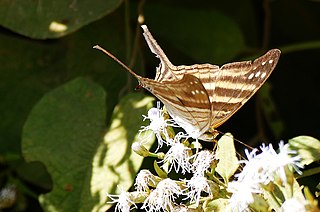
Convolvulaceae, known commonly as the bindweed or morning glory family, is a family of about 60 genera and more than 1,650 species of mostly herbaceous vines, but also trees, shrubs and herbs, and also including the sweet potato and a few other food tubers.

The Aderidae, sometimes called ant-like leaf beetles, are a family of beetles that bear some resemblance to ants. The family consists of about 1,000 species in about 50 genera, of which most are tropical, although overall distribution is worldwide.

Aderus is a genus of leaf beetles of the family Aderidae that resemble ants. The genus was named by John Obadiah Westwood in 1829.

Neoplanorbis is a genus of small, freshwater, air-breathing snails. They are aquatic pulmonate gastropod mollusks in the family Planorbidae, the ram's horn snails.

Neoplanorbis tantillus is a species of very small air-breathing freshwater snail, an aquatic gastropod mollusk in the family Planorbidae, the ram's horn snails. This species is endemic to the United States. In 2012, it has been declared extinct by the IUCN Red List of Threatened Species.
Risella tantillus is a species of sea snail, a marine gastropod mollusk in the family Littorinidae, the winkles or periwinkles.
Tantillus is a genus of beetles in the family Carabidae, containing the following species:

Metalectra tantillus, the black fungus moth, is a moth of the family Erebidae. The species was first described by Augustus Radcliffe Grote in 1874. It has been recorded from the US states of Alabama, Florida, Georgia, Illinois, Iowa, Kentucky, Maryland, Mississippi, New Jersey, North Carolina, Ohio, Oklahoma, Pennsylvania, South Carolina, Tennessee, Texas, West Virginia and Wisconsin.
Aderus feai is a species of beetles from the family Aderidae, the ant-like leaf beetles. It occurs in Cape Verde. The species was described in 1906 by Maurice Pic, who named it after zoologist Leonardo Fea.

Chrysanthrax is a genus of bee flies in the family Bombyliidae. There are more than 50 described species in Chrysanthrax.
Bacanius is a genus of clown beetles in the family Histeridae. There are more than 70 described species in Bacanius.
Bradycellus tantillus is a species of ground beetle in the family Carabidae. It is found in North America.

Aderus populneus is a species of ant-like leaf beetle in the family Aderidae. Native to the west Palaearctic (very common in England, it has been introduced in North America. Large eyes, pubescent antennae, 1.5-2mm

Proteides mercurius, the mercurial skipper, is a species of dicot skipper in the butterfly family Hesperiidae. It is found in the Caribbean Sea, Central America, North America, and South America.

Marpesia chiron, the many-banded daggerwing, is a species of daggerwings, map butterflies in the family Nymphalidae. It is found in Central America, North America, and South America.
Aradus funestus is a species of flat bug in the family Aradidae. It is found in North America.
Aradus depictus is a species of flat bug in the family Aradidae. It is found in North America.
Aderus brunnipennis is a species of ant-like leaf beetle in the family Aderidae. It is found in the Caribbean Sea and North America.
Bacanius tantillus is a species of clown beetle in the family Histeridae. It is found in North America.
The Kimberley wedge-snout ctenotus is a species of skink found in the Northern Territory and Western Australia.






